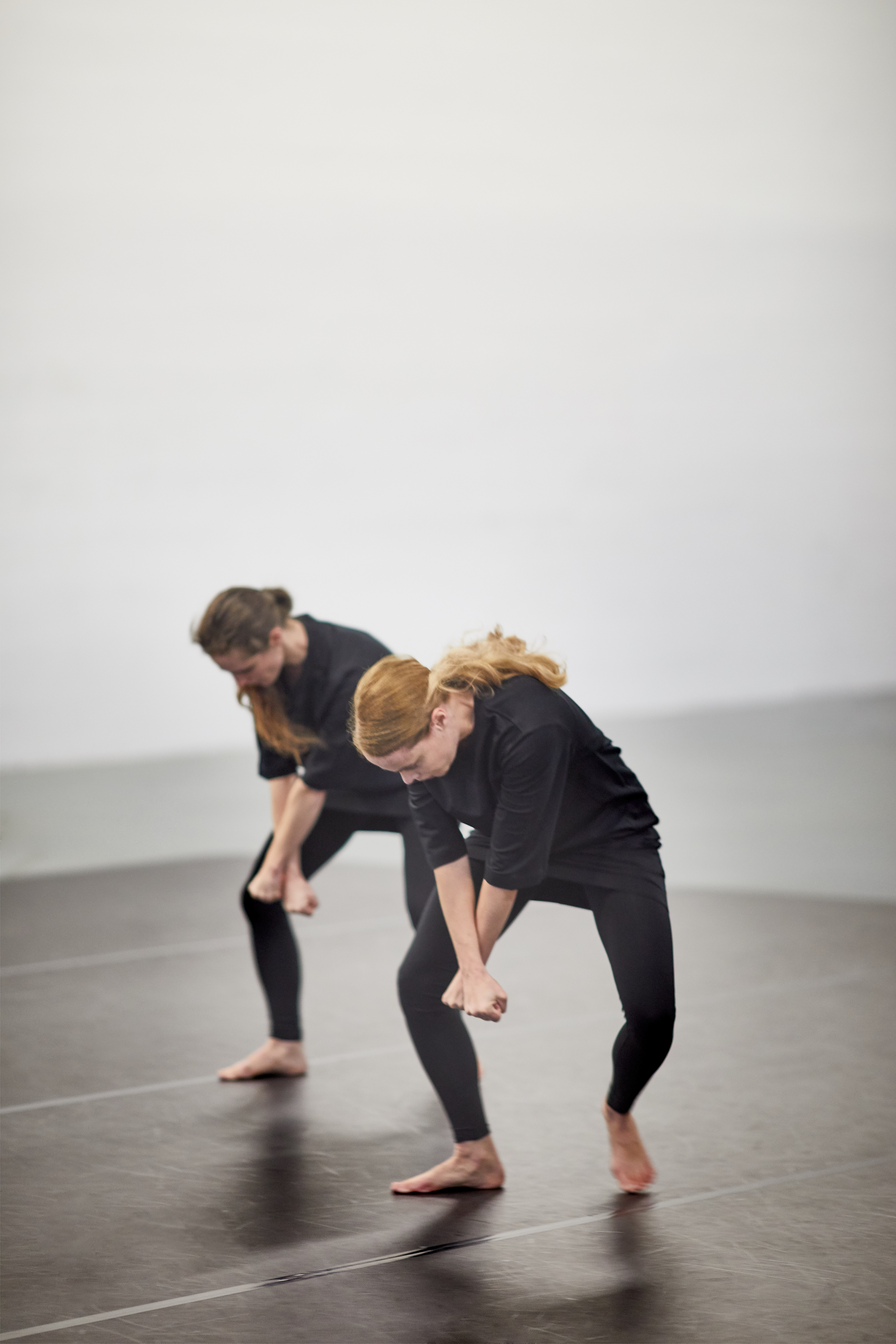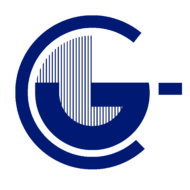
Études wigmaniennes
20 min
duo
Chorégraphe : Gundel Eplinius (1920-2007), élève de Mary Wigman à Dresde entre 1937 et 1939
Reconstruction et transmission : Aurélie Berland – d’après la partition Laban notée par Anja Hirvikallio : Ausschnitt aus der tanzpädagogischen Arbeit von Gundel Eplinius nach Richtlinien von Mary Wigman (2007)
Interprétation : Anne-Sophie Lancelin et Aurélie Berland
Musique: montage pour métronome, 7ème Symphonie en A majeur, Op. 92 de Ludwig Van Beethoven (dirigé en live en 1943 par Wilhelm Furtwängler) et des extraits des Carmina Burana de Carl Orff (dirigés par Eugen Jochum en 1968)
Lumières : Flore Dupont
Le duo Études Wigmaniennes est un extrait de la création Les statues meurent aussi qui reconstruit des archives partitionnelles de danse moderne allemande.
Études wigmaniennes compile des partitions chorégraphiques d’études de Gundel Eplinius, pédagogue et chorégraphe allemande, qui traversent sept thèmes : balancer, le sol, la tension, sauter, marcher, vibrer et glisser.
Texte de la conférence dansée sur les Etudes wigmaniennes à Linz, Autriche, Université Anton Bruckner, décembre 2018
As a laban notator, i will present and dance a reconstruction of a laban score i performed in june at Paris: (image1) Excerpt from the dance education work of Gundel Eplinius according to the guidelines of Mary Wigman This is the title of the archive that I would like to present today. It’s a compilation of notations of exercises and studies by Gundel Eplinius, who was a pupil of Mary Wigman between 1937 and 1939 The notation used is Laban notation or Kinetography, a system published in 1928 by Rudolf Laban. In this compilation you find: – 78 notations (that we called kinetograms) by Anja Hirvikallio published in 2007, the year of the death of Gundel Eplinius. – and a document written by Gundel Eplinius. It is called « a Wigman technique for today’s dancers ». A very interesting title which shows the attempt by Gundel Eplinius to formalize as a « technique » the teaching of Mary Wigman. It is surprising in a way because it is said that Mary Wigman did not have a technique, and on the contrary sought to get rid of any codification. Mary Wigman could add as in 1931 in a conference in Paris : “the single gesture does not make the dance, but rather the manner in which the gestures are connected in movement.” Therefore the first question that may interest us is how did Gundel Eplinius solve this paradox of transmitting in a form a dance that is not formal, to transmit the untransmissible ? The second reflection is to understand how Gundel Eplinius developed and adjusted this teaching to the contemporary body, and therefore how she distanced herself from Mary Wigman. To answer the first question: In the introduction, the notator explains that Gundel Eplinius wants the exercices to be used creatively. The proposed exercises are presented as hypotheses, examples that can find other formal resolutions. The exercises are classified into 5 « subjects” and there are longer exercises, called “studies” for each subject which is the material I reconstructed. This classification makes us understood that the technique proposed has nothing to do with the technical warm-up. The pedagogy of Gundel Eplinius appears more like a technique of improvisation and composition. It consisted in starting from a « subject », proposing exercises and making them more complex until bilding a study. This is probably the pedagogical method that she received from Mary Wigman. When I met the score, I didn’t know that because I couldn’t understand the introduction in German and I was looking for a practice of Wigman dance while I was working on a reconstruction of a solo of Karin Waehner. I found something I didn’t expect from the figure of wigman’s dance and I decided to reconstruct all the studies. So, I found that the notations of the studies were stimulating in themselves and that they taught us a lot (beyond the pedagogy) about Mary Wigman’s dance, about the diversity of her choreographic landscapes and perhaps also about the dance of that time, especially its relationship to rhythm. I will present you the reconstruction of the studies of this collection and then I will explain in a few words the choice that I made in this process, which is still in progress. La compilation des études The order of the studies is not the order of the collection. It imposed itself organically like this : swinging, floor work, tension, rebounding, walking, mechanical tension, vibrating, hopping and sliding. I made small modifications like the change of orientations in the study of vibration, and created transitions between the dances. I first worked, without taking into account the tempo indications in the score. So the dance lasted 30 minutes, the duration of the music I first used : The Transfigured Night composed by Arnold Schoenberg in 1899. The notator Anja Hirvikallio advised me to respect the tempo indicated in the score. So I did, using a metronome. This reduced the dance by more than 10 minutes and the themes appeared quite differently. But why choosing the music of Beethoven and Carl Orff and why did I keep the metronome along with them ? Le choix des musiques : Two studies of the collection (« gleiten » and « Federn und springen ») were composed on the first two songs of Carl Orff’s Carmina Burana, with lyrics on the side. There is no other indication of music in the score. Carl Orff composed Carmina Burana in 35-36, as a remake of profane songs from a medieval manuscript. He was one of the favorite composers of the Nazi regime. Mary Wigman had choreographed on this music in 1943. I found it interesting to keep this music as a reference to the context of the Second World War, when Gundel Eplinius studied with Mary Wigman (between 37 and 39) and began her career as a dancer and teacher ; a context when modern dance was ideologically engaged. The brilliant research by Laure Guilbert, Dancing under the Third Reich enlightened me on this subject. She explained the “The paradox of a dance that is not censored as modern art nor accused of being a degeneration.” “The regime appropriates the basis of the approach to movement developed by dancers and gymnasts in the 1910s: the principle of rhythm, saving of effort and organicity (or totality)” (In 1940, she danced in The Deutsche Tanzbühne, a national company in the Deutsche Meisterstätten für Tanz in Berlin surrounded by dancers, choreographers and regime-friendly teachers like Mary Wigman: Harald Kreutzberg, Dore Hoyer and Rosalia Chladeck.) I realised that Schoenberg’s twelve-tone music was unwelcome if I wanted to musically contextualize these dances, to convey the atmosphere of Gundel Eplinius’s years of professional training. The Nazi regime valued the representatives of the German musical tradition, such as Ludwig Van Beethoven. That explain my choice of the second music taken from the 7th Symphony of Beethoven, recorded live in 1943 in Berlin under the conduction of Wilhelm Furtwängler (who was very appreciated but no less controversial in his attitude). I think that in this recording we feel a certain tension, a musical restraint. Finally, regarding the choice of Carl Orff’s music, I would like to add that his musical theme O Fortuna! recalls the common theme of the dance according to Mary Wigman : « the man and his fate ». (it’s an other quote from the conference in 1931 in Paris) Le rythme : As for the choice of the metronome, for me it evokes the specific relationship of modern dance with rhythm. Mary Wigman, in the same conference, expressed: « « the rhythmical attitude » towards life is the mark of identification born in our time which impels the people of today to « dance expression ». » For Jaques-Dalcroze, whose teaching had a huge influence on the developpment of modern dance: « The movement is music that has become visible in rhythmic gymnastics. No more no less » (Salzmann). Mary Wigman, who studied in 1913 with Dalcroze and Laban before to create her own school in 1920 in Dresde, the dance is liberated from the music by finding its own music in the expression of the rhythm. In her 1931 conference in Paris, she said: « the rhythm is the original and motivating force of the dance ». « Since the dance … evolved absolutely from rhythm, it meets the percussion instrument in its search for a related sound entity. The drum, the gong, the cymbal and all their different variations are suited to catching and emphasising the rhythm of the modern dancer. » In addition, to the questions « What does the dance convey? What can the spectator experience thru it? » Mary Wigman answers « the spectator should take in the rhythm and the music of the dancer’s body in order to get into the same or similar exaltation as that of the dancer. » « Dance is simply rhythmical swinging or or ebb and flow in which even the minuest gesture is carried along by the unending tide of movement ». The importance of the rhythm is probably the reason why Karin Waehner (a pupil of Mary Wigman), teached « rhythmics » and not « dance » in France in the 1950s. The metronome is both a technical and contextual support, but it also allows me to take a certain distance in the solo performance from the suggested power of these symphonic musics. The metronome indicates the present of the reconstruction. Conclusion : To conclude, I would like to say that I choose to use the score this way but there are also other possibilities: – This document can be a wonderful support for choreographic training : analysis of the poetics of the composition of the studies from exercices. I really feel that the work of Gundel Eplinius, through the notation, articulates the language of the dance. – The scores can also become a support for the teaching of Laban kinetography because each theme develops a specific notion of kinetography. – At the end, it can be a support for theoretical researches. I recognise the relevance of the notator in the choice to note the dances of Gundel Eplinius, who crossed the modernity from Hamburg (which perhaps explains her link to the Laban tradition also) to Dresden and Berlin. We can feel that the document synthesises the research of that time according to Mary Wigman’s spirit, always open to creativity, always open to the present. As a contemporary dancer, I was particularly surprised by the study of tension and vibration, and the work on the legs and the speed of many dances challenged me. On this subject, I wonder if Gundel Eplinius developed the technique of the legs, a kind of virtuosity, because she considered it missing from the Wigman’s technique. I let the experts of Mary Wigman and this period find out what was related to her or not… For myself, I would like to continue this questioning around the rhythm and in particular to measure the influence of Dalcroze’s teaching at Hellerau in Germany and Austria (image) and question the virtuosity of the modern body (in the technique of the legs but also in its relation to gymnastics). I’m particularly interested to reconstructe an archive of the 50’s from Knust’s collection : Rhythmic Gymnastics by Dorothée Gunther even though Mary Wigman explains that « the dance begins where gymnastics leave off ».
